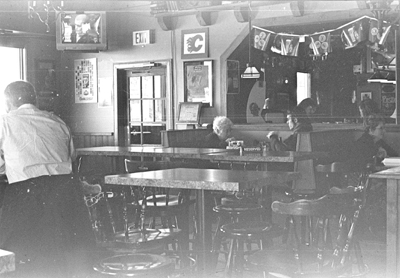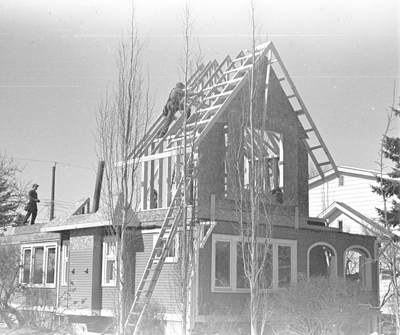|
The Frugal Photographer's "coffee and vitamin C" developer works. Here's proof.
This is an un-retouched scan. Note the same scratches as in the photo above. That's the perils of pawnshop cameras.
The film was a grainy ISO 400 traffic surveillance film from the Czech Republic that we quit selling (for good reasons) a year ago. You may know the film — a European supply house that we no longer represent had been selling it repackaged under their house brand name. Oddly enough, they discontinued it about the same time we realized it was never going to be a decent retail product. You can buy comparable film on eBay for 50 cents a roll. I continue to use our remaining stock of films because... well, because they're there. I just ignore the way its edges go foggy. Scanning in a 3600 dpi film scanner ($145 on eBay) dug out an absolutely amazing amount of shadow detail. The pub scene was photographed in all natural light diffusing gently from the pub's north- and west-facing windows. Nobody in their right mind sets off a flash in a pub. The house was photographed in bright afternoon sunlight. On the negative, the front of the house appeared devoid of detail, but the scanner proved that there was considerable detail actually captured there. The camera was a Pentax ME-Super purchased at noon that same day from a pawn shop for $45. It's quite dirty, with an erratic, grinding film advance, and grit in the film plane that puts full-length scratches along the length of the film. The previous owners must have taken it to a few too many beaches. The meter seems accurate. The shutter is flawless. The lens has a little bloom that looks like the detritus of a few years proximity with a smoker. It will come off easily with Windex and a Q-tip. Cleaning the camera so it operates as smooth as new will take about an hour some rainy summer morning. I'll remove the baseplate and flush the gears with lighter fluid, being careful to not let lighter fluid migrate into the camera body. The top plate might have to come off so the film-advance and frame-counter mechanisms there can be flushed. But maybe not. Then an almost invisible ultra-thin touch of white lithium grease on the tips of the gear teeth, applied with a wooden toothpick. That will be all it takes. I think. The developer: instant coffee plus vitamin C, in washing soda. 15 minutes development time. Ignore the fact that these are not up to Ansel Adams standards. Just glory in the fact that it was a $45 camera exposing a $0.50 roll of film which was developed in chemicals bought for next to nothing at a supermarket. |

